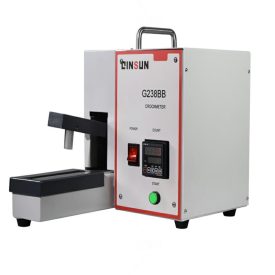
Electric friction color fastness tester
The electric friction color fastness tester is designed as a whole, mainly composed of a base, a friction transmission mechanism, and a counter. The sample and sandpaper are fixed on one side of the base with a sample clamp. The handle is shaken to make the friction head containing white cotton cloth move back and forth on the sample according to the specified stroke, causing the white cotton cloth and sample to rub against each other. After ten frictions, the adhesion degree on the white cotton cloth is observed and evaluated by comparing it with a gray card, Evaluate the stability of dyeing or surface coating on fabric samples, providing reference data for material evaluation and selection. This instrument is mainly used in industries such as cotton, wool, linen, silk, knitting, printing and dyeing, and serves as a testing instrument for testing the color fastness of various fabrics to dry and wet friction.
Compliant with standards:
ASTM F1319, AATCC 8/165, BS 1006 D02, GB/T 3920, ISO 105 D02/X12, JIS L0849, M&S C8/C8A, NEXT TM6
Instrument features:
Used for testing the color fastness of fabrics to dry and wet rubbing, suitable for regular or periodic testing.
A. Friction head diameter: 16mm or 25mm;
B. Provide pressure of 9N;
C. Electric drive requires a working voltage of 220V;
D. Equipped with an electronic counter, it fully simulates the test results of manual friction ten times, with high data reproducibility;
E. Fixed device with standard friction fabric;
F. The sample clamp is made of spring steel, ensuring quick fastening of the sample;
G. Equipment control method: There are internal standards such as AATCC and ISO, and programs can also be set up independently;
H. Equipped with automatic alarm function after testing.
Accessories and consumables:
1. Friction cloth sample holder
2. Standard friction sandpaper
3. Friction small white cloth (AATCC/ISO standard)
4. Friction small white cloth (SDC)
5. Calibrate the fabric
6. Grey card (stained) - ISO/BS standard
7. Grey card (stained) - AATCC standard
Measurement steps:
1. Sample preparation:
1.1 The sample and standard friction white cloth shall be conditioned in a constant temperature and humidity environment.
When the sample has multiple colors, all colors should be rubbed against.
1.3 If the area of each color is large enough, samples must be taken separately.
1.4 Cut the sample and perform dry and wet friction separately, ensuring that all colors are rubbed.
If the front and back of the sample are made of different materials and colors, both sides must undergo a color fastness test for friction.
1.6 The dry and wet rubbing fastness should not be repeated on the same part of the sample.
2. Dry friction:
2.1 Place the sample flat on a friction tester covered with sandpaper, ensuring that the length direction of the sample is consistent with the movement direction of the instrument, and fix the sample on the pressure plate. The sample should be clamped flat.
2.2 Fix the standard friction small white cloth on the friction head, clamp it with a spring clamp, and gently place the friction head on the specimen;
2.3 Ensure that the specimen does not slide or wrinkle during friction;
2.4 Place the friction head on the specimen. Turn on the power and turn on the POWER button. Set the number of tests.
2.5 Press the START key to start the test. When the number of tests reaches the set value, the instrument automatically stops.
2.6 Remove the standard friction white cotton cloth and compare it with a color chart for rating.
3. Wet friction:
3.1 Completely immerse the standard friction small white cloth in distilled water;
3.2 After removal, clamp it in filter paper and squeeze it to have a certain moisture content;
3.3 The remaining steps are the same as the dry friction test steps mentioned above;
4. Result processing:
Before rating, use transparent adhesive to gently remove any loose fuzz from the white cloth.
4.2 Use three layers of unused friction white cloth to pad under the friction white cloth to be evaluated, and evaluate the staining level of the friction small white cloth according to the standard staining gray card.
5. Test report:
5.1 Reporting Standard Methods
5.2 Report the results of dry and wet friction separately.